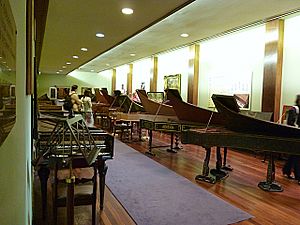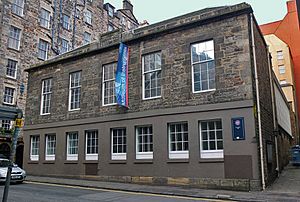Russell Collection facts for kids

The public display of keyboard Instruments
|
|
| Established | 1968 |
|---|---|
| Location | St Cecilia's Hall, Niddry Street, Edinburgh |
| Type | keyboard instrument collection |
| Collection size | 21 instruments |

The Russell Collection is a special group of old keyboard instruments. These instruments were collected by a British musician named Raymond Russell. He was a harpsichordist, which means he played the harpsichord. He was also an organologist, someone who studies musical instruments.
This collection is now part of the University of Edinburgh's Musical Instrument Museums. You can find it in a place called St Cecilia's Hall in Edinburgh, Scotland. Its full name is the Raymond Russell Collection of Early Keyboard Instruments.
Contents
Discovering the Russell Collection
This collection is famous for having many different types of old keyboard instruments. These include clavichords and harpsichords. These instruments are like early versions of the piano. They were popular in the 1600s and 1700s.
How the Collection Started
Raymond Russell bought his first old keyboard instrument in 1939. Over the next 20 years, he gathered many instruments. His collection included instruments from different parts of Europe. He had instruments from England, Italy, and the Flemish area. He also had instruments from France and North Germany.
Russell even wrote a book about some of his instruments. It was called The Harpsichord and Clavichord: an Introductory Study. He published it in 1959.
A Gift to the University
By 1960, Raymond Russell decided to give his collection to the University of Edinburgh. He wanted it to be a place where people could study old keyboard instruments. Sadly, he passed away suddenly in 1964 when he was only 41.
Later that year, his mother, Maud Russell, gave almost all his collection to the university. This included 19 instruments. She also gave his notes and photos. The collection found its home in St Cecilia's Hall in Edinburgh. The hall opened as a museum in 1968. A famous musician, Gustav Leonhardt, played at the opening.
The university later bought two more instruments from Russell's collection. This brought the total number of instruments to 21.
Amazing Instruments in the Collection
The collection has instruments from five main areas where harpsichords were made. These areas are England, Flanders, France, Germany, and Italy. The instruments show over 200 years of how these musical tools were made.
Instruments from England
The English instruments in the collection show how instrument making changed over time. They include different types of spinets and harpsichords. A spinet is a smaller type of harpsichord.
- One instrument is a rectangular virginals made in 1668.
- There is also a spinet from around 1705.
- Another is a harpsichord from 1720.
- A beautiful spinet from 1728 is also part of the collection.
- There's a spinet made in 1757.
- A very decorated harpsichord from 1755 is also featured.
- A Scottish spinet made in Edinburgh in 1784 is included.
- Finally, a harpsichord from 1793 is also in the collection.
Instruments from Flanders
There are four Flemish harpsichords in the collection. All of them were made in Antwerp. These instruments are known for their rich sound.
- One is a harpsichord made in 1608.
- Another is a harpsichord from 1637.
- A special harpsichord from 1638 can change its pitch.
- The last Flemish instrument is a harpsichord made in 1645.
Instruments from France
The collection has two French instruments. They are known for their elegant design and sound.
- One harpsichord was made in 1764 and later rebuilt in 1783-1784.
- The other French harpsichord was made in 1769.
Instruments from Germany
The collection includes two instruments from North Germany. Both were made in Hamburg.
- One is a clavichord from 1763. A clavichord is a quiet keyboard instrument.
- The other is a harpsichord made in 1764.
- There is also a small German clavichord from about 1700.
Instruments from Italy
The Italian instruments in the collection are some of the oldest. They show the early history of keyboard instruments.
- One is a virginal made in 1586.
- Another is a harpsichord from around 1620.
- There is also a harpsichord with three keyboards from 1627.
- Finally, a small spinet called an ottavino from 1710 is part of the collection.

